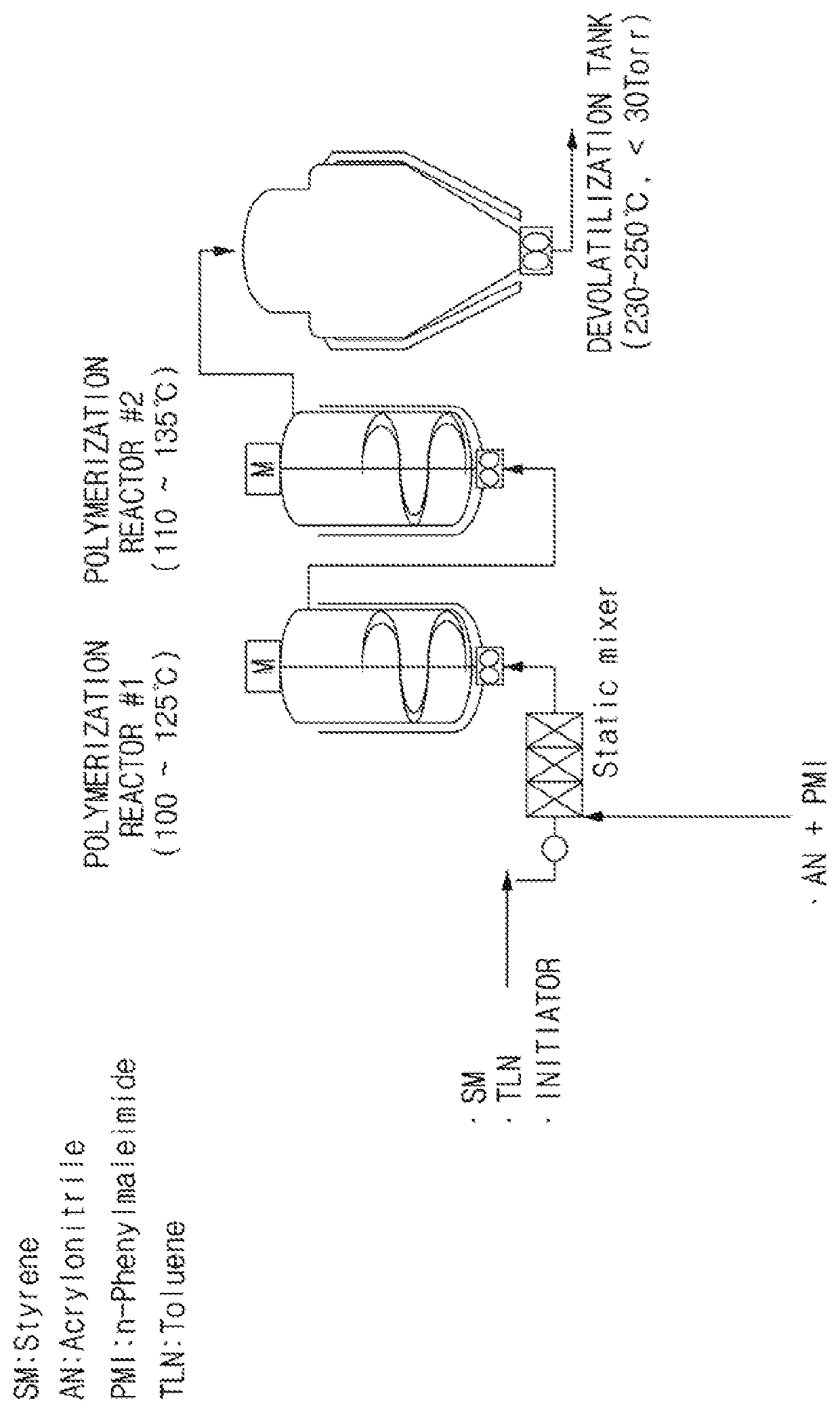Styrene-acrylonitrile resin with high thermal resistance and method for producing the same
a technology of acrylonitrile and styrene, which is applied in the field of styreneacrylonitrile (san) resin with high thermal resistance, can solve the problems of low polymerization rate and conversion rate, low polymerization rate, and poor thermal resistance, and achieves high processing efficiency, improved thermal resistance, and high processing efficiency
- Summary
- Abstract
- Description
- Claims
- Application Information
AI Technical Summary
Benefits of technology
Problems solved by technology
Method used
Image
Examples
example 1
[0066]A solution of N-phenylmaleimide (PMI) and acrylonitrile (AN) (PMI+AM solution) was prepared by dissolving 55 parts by weight of PMI in 45 parts by weight of AN with respect to the total weight of the solution at a temperature of 61° C.
[0067]The PMI+AN solution prepared as thus, a styrene (SM), and toluene (TLN) were introduced into a static mixer at the front end of a first polymerization reactor at a rate of 2.1 kg / hr, 2.7 kg / hr, and 3.2 kg / hr, respectively. Then, to prepare a polymerization solution, an initiator (1,1-di(t-butylperoxy)cyclohexane) in an amount of 0.02 parts by weight with respect to the total feed amount of the polymerization solution (8 kg / hr) was introduced into the static mixer.
[0068]The polymerization solution was introduced into the first polymerization reactor, whose temperature was maintained at 120° C., and then into a second polymerization reactor, whose temperature was maintained at 130° C., to carry out a continuous bulk polymerization reaction. T...
examples 2 to 5
, Comparative Examples 1 to 4
[0069]The SAN resins of Examples 2 to 5 and Comparative Examples 1 to 4 were produced by varying the conditions used to produce the SAN resin of Example 1 as shown in Table 1 provided below.
experimental example 1
[0070]The material properties of the resins produced according to Examples 1 to 5 and Comparative Examples 1 to 4 were comparatively analyzed as follows, and the results are listed in Table 1 provided below.
[0071]1) Oligomer Content (%)
[0072]The amounts of oligomers contained in each resin were determined by gel chromatography.
[0073]2) Glass Transition Temperature (° C.)
[0074]The glass transition temperature (Tg) was determined using 10 mg of each resin subjected to a rising temperature of 10° C. / min and a nitrogen flow of 50 cc / min by using a Q20 differential scanning calorimeter (DSC) from TA Instruments.
[0075]
TABLE 1ExampleExampleCharacteristics12Example 3Example 4Example 5CompositionPMI:AN55:4555:4555:4555:4555:45ratio ofPMI + ANsolutionTemperature of PMI + AN mixed6152616161solution (° C.)Feed amount ofPMI + AN2.12.12.12.12.1polymerizationSM2.72.72.72.72.7solutionTLN3.23.23.23.23.2(kg / hr)Passed through static mixerOOOOOTemperature ofFirst120120125105120polymerizationpolymerizat...
PUM
| Property | Measurement | Unit |
|---|---|---|
| temperature | aaaaa | aaaaa |
| temperature | aaaaa | aaaaa |
| temperature | aaaaa | aaaaa |
Abstract
Description
Claims
Application Information
 Login to View More
Login to View More - R&D
- Intellectual Property
- Life Sciences
- Materials
- Tech Scout
- Unparalleled Data Quality
- Higher Quality Content
- 60% Fewer Hallucinations
Browse by: Latest US Patents, China's latest patents, Technical Efficacy Thesaurus, Application Domain, Technology Topic, Popular Technical Reports.
© 2025 PatSnap. All rights reserved.Legal|Privacy policy|Modern Slavery Act Transparency Statement|Sitemap|About US| Contact US: help@patsnap.com

